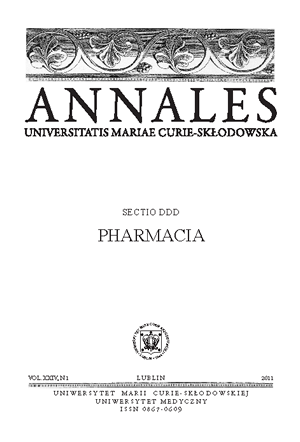Development and comparison of HPLC method with fluorescence and spectrophotometric detections for determination of sparfloxacin
Keywords:
HPLC, UV-fluorescent detection, sparfloxacinAbstract
An attempt was made to develop a simple, rapid, specific, precise and accurate RP-HPLC method with combined fluorescence and spectrophotometric detection and with simple mobile phase for determination of sparfloxacin (SPA). The comparison of both detection methods showed no significant differences with reference to precision and accuracy. A method thus developed was applied for the quantification of sparfloxacin in pure substance. The method was validated according to the ICH guidelines in respect to linearity, limit of detection, precision, accuracy, robustness, and selectivity. The developed HPLC method was successfully applied for assay of SPA pharmaceutical formulation to check the applicability of the proposed methodology.
References
1. Argekar A.P., Shah S.J.: Stability indicating HPLC method for the determination of sparfloxacin (SPAR). Anal. Lett., 32(7), 1363, 1999.
2. Borner K., Borner E., Lode H.: Determination of sparfloxacin in serum and urine by high-performance liquid chromatography. J. Chromatogr., 579 (2), 285, 1992.
3. Cho H-Y., Park S-A., Lee Y-B.: Improvement and validation of an HPLC method for examining the effects of the MDR1 gene polymorphism on sparfloxacin pharmacokinetics. J. Chromatogr. B Analyt. Technol. Biomed. Life Sci., 834(1-2), 84, 2006.
4. Du L.M. et al.: Determination of sparfloxacin in human urine by reversed-phase high performance liquid chromatography with nitrous acid and hydroiodic pre-column derivatization. Chinese Chemical Letters, 12(11), 1007, 2001.
5. Gupta H. et al.: Development and validation of a stability-indicating RP-UPLC method for the quantitative analysis of sparfloxacin. J. Chromatogr. Sci., 48(1), 1, 2010.
6. Kamberi M. et al.: Determination of sparfloxacin in plasma and urine by a simple and rapid liquid chromatographic method. Ther. Drug Monit., 21(4), 411, 1999.
7. Kowalczuk D., Hopkała H., Gumieniczek A.: Application of solid-phase extraction of fluoroquinolone derivatives from a biological matrix to their biodetermination by liquid chromatography. J. Liq. Chromatogr. Relat. Technol., 26(11), 1731, 2003.
8. Kowalczuk D., Hopkała H., Pietraś R.: Comparison of HPLC and classical- and derivative UV-spectrophotometric methods for the quantification of sparfloxacin. Chem. Anal.-Warsaw, 49(2), 201, 2004.
9. Kudo M., Ohkubo T., Sugawara K.: Determination of sparfloxacin in plasma by direct injection high performance liquid chromatography with column switching. J. Liq. Chromatogr. Relat. Technol., 22(3), 441, 1999.
10. Li Q. et al.: Comparative study on salivary distribution of fluoroquinolones in rats. Biol. Pharm. Bull., 25(8), 1084, 2002.
11. Li Y.L. et al.: Rapid determination of 19 quinolone residues in spiked fish and pig muscle by high-performance liquid chromatography (HPLC) tandem mass spectrometry. Food Addit. Contam. Part A Chem. Anal. Control Expo. Risk Assess., 26(3), 306, 2009.
12. Ling T., Yuan-Da Z., Hai-Xia H.: Study on the distribution and pharmacokineties of sparfloxacin in ocular tissues after oral administration in rabbits. Chinese J. Antibiot., 33(4), 235, 2008.
13. Liu S-J. et al.: Pharmacokinetics and bioequivalence of sparfloxacin tablets in healthy volunteers. Pharmaceutical Care and Research, 8(1), 38, 2008.
14. Lyon D.J. et al.: Rapid HPLC assay of clinafloxacin, fleroxacin, levofloxacin, sparfloxacin and tosufloxacin. J. Antimicrob. Chemother., 34 (3), 446, 1994.
15. Marona H.R.N., Schapoval E.E.S.: A high-performance liquid chromatographic assay for sparfloxacin. J. Pharm . Biomed . Anal., 20(3), 413, 1999.
16. Marona H.R.N., Schapoval E.E.S.: Performance characteristics of bioassay, UV-spectrophotometry and high performance liquid chromatographic determination of sparfloxacin in tablets. Revista Brasileira de Ciencias Farmaceuticas/Brazilian Journal of Pharmaceutical Sciences, 37(2), 171, 2001.
17. Marona H.R.N., Zuanazzi J.A.S., Schapoval E.E.S.: Determination of sparfloxacin and its degradation products by HPLC-PDA. J. Antimicrob. Chemother., 44(2), 301, 1999.
18. Nakamura S. et al.: In vitro and in vivo antibacterial activities of AT-4140, a new broad-spectrum quinolone. Antimicrob. Agents Chemother., 33(8), 1167, 1989.
19. Rahman N.N., Ahmad S.: Developement of quantitative analysis of sparfloxacin by high performance liquid chromatography. Dhaka University Journal of Pharmaceutical Sciences, 6(1), 21, 2007.
20. Salgado H.R.N. et al.: Photodegradation of sparfloxacin and isolation of its degradation products by preparative HPLC. Revista de Ciencias Farmaceuticas Basica e Aplicada, 26(1), 47, 2005.
21. Srinivas N. et al.: Development and validation of a HPLC method for simultaneous quantitation of gatifloxacin, sparfloxacin and moxifloxacin using levofloxacin as internal standard in human plasma: Application to a clinical pharmacokinetic study. Biomed. Chromatogr., 22(11), 1288, 2008.
22. Yue Z. et al.: Determination of 16 quinolone residues in animal tissues using high performance liquid chromatography coupled with electrospray ionization tandem mass spectrometry. Chinese J. Chromatogr., 25(4), 491, 2007.
Downloads
Published
Issue
Section
License
Copyright (c) 2011 Authors

This work is licensed under a Creative Commons Attribution-NonCommercial-NoDerivatives 3.0 Unported License.


